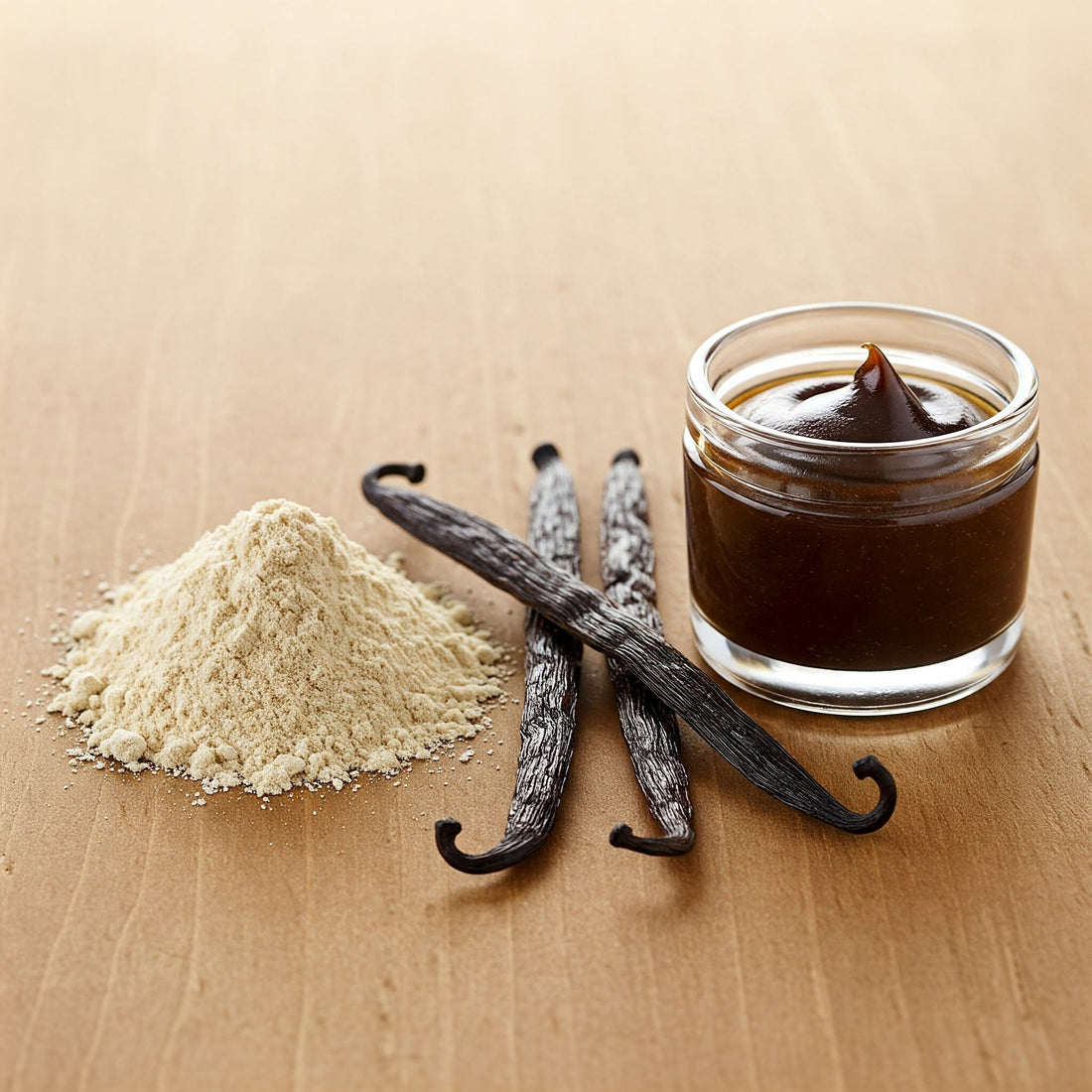
VANILLA EXTRACT VS. VANILLA BEAN PASTE VS. VANILLA ESSENCE
Share
WHAT'S THE DIFFERENCE BETWEEN VANILLA EXTRACT, VANILLA BEAN PASTE, AND VANILLA ESSENCE, AND WHICH ONE SHOULD YOU USE FOR YOUR BAKING NEEDS?
When it comes to enhancing the flavor of baked goods, few ingredients can match the versatility and allure of vanilla. From cookies and cakes to custards and ice creams, the warm, aromatic notes of vanilla elevate these treats to new heights of indulgence.
However, navigating the world of vanilla products can be a daunting task, with numerous options available, each boasting its unique characteristics and applications. In this comprehensive guide, we'll explore the differences between vanilla extract, vanilla bean paste, and vanilla essence, helping you make an informed decision for your culinary endeavors.
Vanilla Extract: The Classic Staple
Vanilla extract is perhaps the most widely recognized vanilla product. Made by steeping vanilla bean pods in a solution of alcohol and water, this liquid extract captures the essence of vanilla in a concentrated form. Its production process takes time, with the beans typically soaked for several months to extract their rich flavor and aroma.
One of the significant advantages of vanilla extract is its potent and consistent flavor. A little goes a long way, making it a cost-effective option for home bakers. Additionally, vanilla extract has a long shelf life, ensuring that your bottle will maintain its quality for an extended period.
Vanilla extract shines in a variety of baked goods, from cookies and cakes to custards and frostings. Its liquid form makes it easy to incorporate into batters and doughs, ensuring even distribution of flavor throughout the finished product. However, it's essential to note that vanilla extract contains alcohol, which can be a consideration for those with dietary restrictions or preferences.
Vanilla Bean Paste: The Indulgent Option
If you're seeking an even more intense and authentic vanilla experience, vanilla bean paste is an excellent choice. This decadent product combines the concentrated flavor of vanilla extract with the tiny, flavorful seeds scraped from the interior of vanilla bean pods. The result is a thick, syrupy paste that not only imparts a rich vanilla taste but also adds visual appeal with its speckled appearance.
Vanilla bean paste is an indulgent option for those who want to elevate their baked goods with a luxurious touch. Its intense flavor and visible vanilla bean specks can add depth and texture to a wide range of desserts, from delicate crème brûlées to luscious cheesecakes.
One of the advantages of vanilla bean paste is its versatility. It can be used in both baked goods and other culinary applications, such as flavoring whipped cream, ice cream, or even savory dishes like sauces and marinades. However, it's important to note that vanilla bean paste is typically more expensive than vanilla extract, making it a more indulgent choice for special occasions or when you want to create truly exceptional treats.
Vanilla Essence: The Affordable Alternative
Vanilla essence, also known as artificial vanilla flavoring or vanilla aroma, is a cost-effective alternative to natural vanilla products. Unlike vanilla extract and vanilla bean paste, which are derived from real vanilla beans, vanilla essence is a synthetic flavoring created in a laboratory to mimic the taste and aroma of vanilla.
While vanilla essence may not offer the depth and complexity of its natural counterparts, it can be a convenient and budget-friendly option for those seeking a vanilla flavor boost without breaking the bank. It's particularly useful for recipes that don't require an intense vanilla flavor or when vanilla is used as a supporting note rather than the star of the show.
Vanilla essence is readily available and often found in the baking aisle of most grocery stores. It's easy to use and can be substituted for vanilla extract in many recipes, although adjustments may be necessary to achieve the desired flavor intensity.
However, it's essential to note that vanilla essence doesn't contain the same natural compounds found in real vanilla, which can affect the overall taste and aroma of your baked goods. Additionally, some people may prefer to avoid artificial flavorings in their cooking, making vanilla essence a less desirable option for those seeking a more natural approach.
Choosing the Right Vanilla Product for Your Needs
When deciding which vanilla product to use, consider your personal preferences, dietary restrictions, and the specific recipe requirements. Here are some general guidelines:
- For traditional, robust vanilla flavor: Opt for pure vanilla extract or vanilla bean paste. These natural products offer a depth of flavor that can elevate your baked goods to new heights.
- For visually stunning desserts: Vanilla bean paste is an excellent choice if you want to showcase the beautiful specks of vanilla bean seeds in your creations, adding a touch of elegance and visual appeal.
- For cost-effective baking: If you're on a budget or don't require an intense vanilla flavor, vanilla essence can be a practical option. It's especially suitable for recipes where vanilla plays a supporting role.
- For dietary restrictions: If you need to avoid alcohol or prefer a vegan-friendly option, look for alcohol-free vanilla extracts or vanilla bean pastes made without animal-derived ingredients.
Regardless of your choice, it's essential to use high-quality vanilla products from reputable brands to ensure the best flavor and aroma in your baked goods. Additionally, follow recipe instructions carefully and adjust the amount of vanilla product used based on your personal taste preferences.
In the ever-evolving world of baking, understanding the nuances between vanilla extract, vanilla bean paste, and vanilla essence can empower you to create truly exceptional treats that tantalize the senses and leave a lasting impression. Experiment, indulge, and let the warm, inviting aroma of vanilla guide you on a journey of culinary delight.



